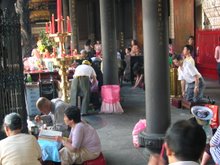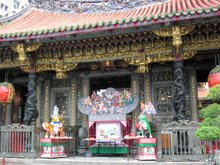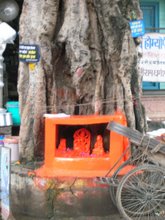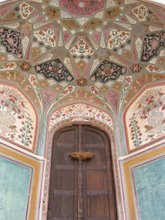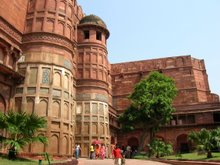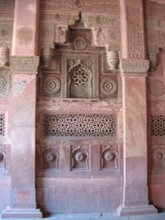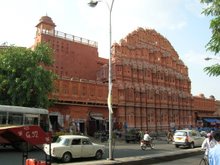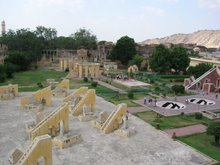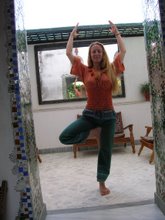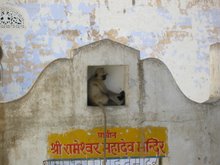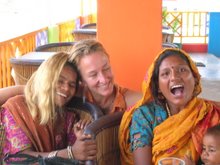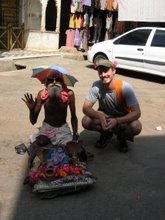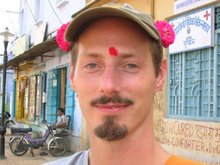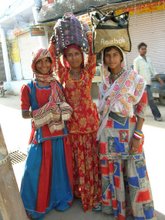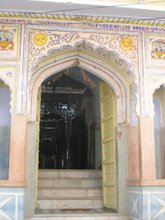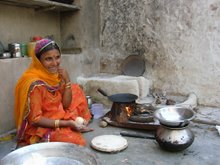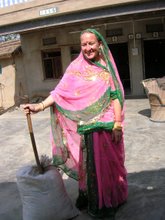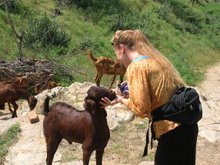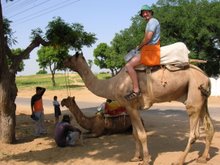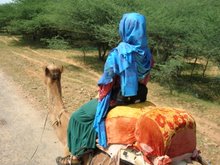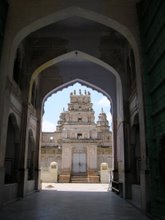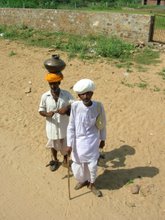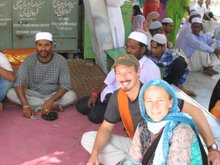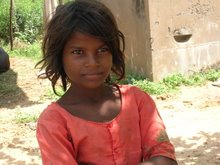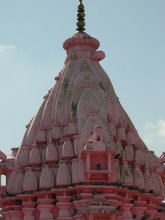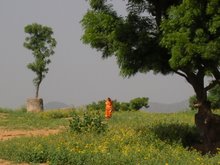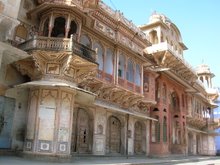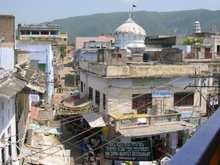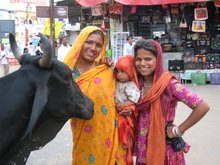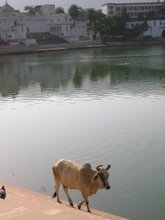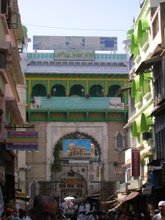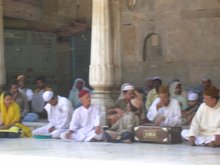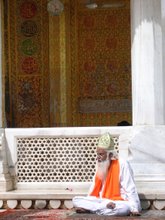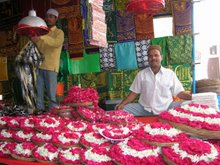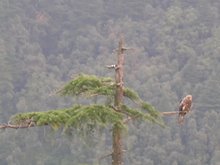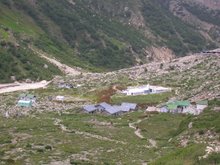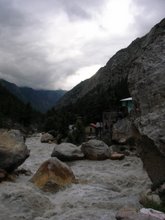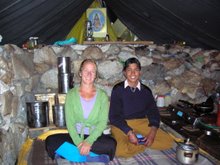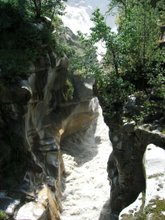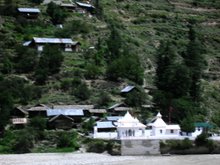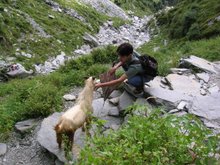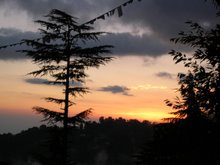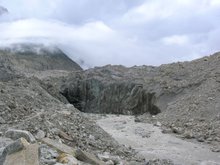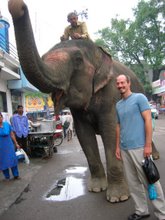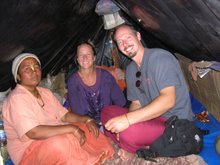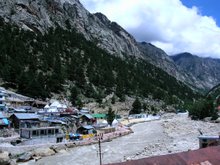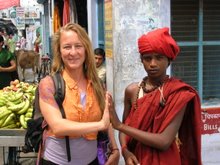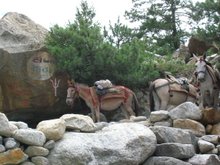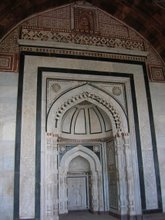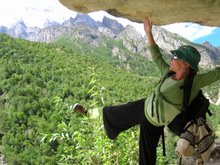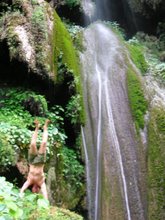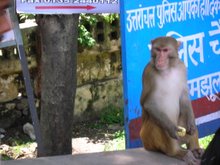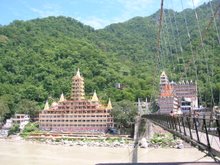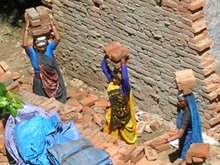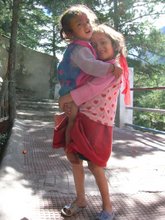Tom and I had a long stint of 15 hours waiting for our connecting flight in Taiwan, and at the airport in bleary morning hours met an easygoing woman traveller who was going on to India with us and to Ladakh to do a photojournalism gig. So, in Taipei we had the pleasurable company of Alison Wright, a freelance photographer working for National Geographic with whom to explore the city. She has worked on many incredible projects and co-created several bestselling books on Buddhist culture and people of southeast Asia (visit her work at http://alisonwright.com/) We visited the oldest Buddhist temple in Taiwan, dedicated to a form of Kuan Yin, by taxi from the (cruddy) airport hotel. Being as aforementionedly pugnacious as the hotel was, we made a quick decision to spend (what we now consider in India to be) outrageous amounts of money on a shared cab to see Taipei. The rainbow-multicolored and intricately hewn, dragon-pillared temple had a large open courtyard area inside with a central shrine with around seventy people and many coming-and-going performing prayers and offering incense. Standing in the sweltering heat with other pilgrims, I tried to connect with bodhicitta and surmount the miserable humidity in the peaceful shrine of the Goddess. The weather was providing a direct opportunity to transcend attachment to comfort, and call to mind the preciousness of the moment, and being on a pilgrimage, and yaddy-yaddy, but it was only a foreshadowing of the weeks ahead we were to get in India heatwise. Alison took pictures of the only really eclectic-looking person there, an elderly Taiwanese woman who looked like a shaman and a fairy all at once with coral and bone necklaces, flowing whimsical clothes, and a spry step. I was touched by how Alison brought out the primadonna in this sweet grandmother who never grew old really inside. She held her face for a long moment like they were old friends, and the lady didn't want Alison to stop taking pictures of her. It was like more of her kept coming out with each shot. That is the magic of a visionary photographer, which upon looking at Alison's websites and galleries later I am sure you'll see she is.
Other than that, due to the heat, the other highlight of Taiwan was getting to visit the largest building in the world, a 101 story skyscraper called eponymously Taiwan 101. Turns out to be a mall, a veritable monument to capitalism, with brand name retailers on every level. I sigh to Tom that such accomplishments by humanity have gone along the wayside in their dedication to such religious sciences as shopping, but perhaps it is a fitting "temple" for the seeming direction of the one-pointed attention of humankind? It's service to humanity was not in vain however as we benefitted greatly from trying out all of the mall's massage chairs and had foot-squeezing ecstacy and a high octane coffee after Tom and Alison soared to the top for a view from an elevator.
Sunday, October 08, 2006
Saturday, October 07, 2006
Delhi Masala
We got to Delhi with smooth sailing and Tom graciously innoculates himself to Delhi at once by forgetting about the danger of it's tap water as he goes to brush his teeth in the airport bathroom after our long flight. His pearly, boyish grin droops in dismay and alarm as I remind him not to use the water for anything consumption-oriented. He is just fine however, and to this, the 3-week anniversary of our living here, we both remain in perfect health. Perhaps even better health in many ways, oddly, having enjoyed a full week of relentless night and day sauna-like purificatory existence during our week in humid Rishikesh, then a week including a 22-mile hike in the Himalayas to Gaumukh glacier at the source of the Ganga, many many cramped jeeps and generally viscerally-friendly purgations of our American habits of convenience, so many of which one realizes are not the real "absolute must-haves" of a balanced life at all...such as personal space, quiet, and environmental cleanliness.
Mother India pulls one deeper and deeper inside for contentment until the whole of the heaving, chaotic swirl of people, movement, horns honking, absurd smells, divine smells, miscellanea plastic and candy stores, fruitstands, diesel, dung and dharma is at rest in its source as pureness in the mind of the one who sees it. That may sound transcendentalist but accosted with so much stimulation there is yet the ever-present availability of something beautiful happening, like a smile from a beautiful child or a staring person suddenly transforming themselves with connected awareness of a shared humanity. There is a heart-centeredness in the people that comes instantaneously through when you are looking with your own. The effect of population density and lack of resource distribution from the cities to rural areas does not seem to hinder the universal adherence to generosity of spirit in Indian people, which is what people in the West seem to notice right away. From the cup of chai offered to each guest being invited in to the home or into the shop, to the spontaneous sharing of a song or dance in tribal areas, to the gift of the very necklaces or malas off of their person that I have received from young people in Uttaranchal and Rajasthan, the example of fearless sharing and the understanding of the potency of the moment bringing people together for a reason deeply inspires one to reach beyond their notions of how much love exists yet in our disparate world. My Indian friends explain it this way: they are constantly aware of the fact that despite whatever hardships they struggle with, they consider their lot in being better off than others who don't have as much as they do, and feel grateful; while in America we obsess over what we don't have and what everyone else has that we would like to gain. It's a matter of cup half-full and half-empty, and an example of what is called "santosha" or contentment potentially found in any kind of circumstance. This daily kind of contentment, borne of the strife of surviving numerous occupations, social oppressions, and factional religious civil upset does not insinuate a lack of desire for progress however. India's phoenix is finally on the rise. Excitingly, India is experiencing an enormous renaissance in terms of becoming a powerful developing nation and in reclaiming its' own heritage, pride, and self-esteem as the world increasingly is made aware of the unique philosophical, architectural and cultural treasures which India has sustained it's traditions through various occupations and economic setbacks for the last 700 years. Given all that they have endured, this is an extremely deserving group of people on the planet to be finally in the sunlight again. May it be the beginning of a global flow of respect and support to other developing countries. The people's strong adherence to maintaining their languages and way of life kept that Sun in the heart of the Indian identity through so much hardship that it's light only burns more strongly now.
The overall effect that India has on me is to sharpen my awareness of the inner Guru, the power-within that guides all of our interactions. Within India's relentless pace there is the potential for ALL kinds of emotions and reactions to be activated by what is being experienced. In the overwhelm --a state of both aftermath and afterglow-- one has the opportunity to recognize the shuddering light of awareness shining on all kinds of potential ways to receive the experience itself; breath by breath through the bombardment of all sorts of paradoxical effects from the environment, interface with people, one's responses to it based on conditioning, and one's attitude. Being in India provokes an acceleration of the basic force of consciousness and self-awareness that Life is perceived from instinctively, unhinging many travelers and inspiring many others in the absence/ freedom from the trappings of a comfort zone with which one can make any sort of ultimate statement about Reality or "how things (fundamentally) are". The effect in heightening one's sense of the coarse, raw, and silken substance of Being is a sort of tightrope ballet that necessitates gracefulness within the psyche to reveal the simple happinesses of life. It is what I come to India for, to experience its' vastly unsettling norms which, with the surgical precision that only Karma itself has, can rap successfully at the cloisonne egg-shell of the Ego to liberate the unconditioned witness resting in bliss as Soul. One also simultaneously learns how to survive by appreciating how quickly those emotions have the potential to change (those of you who sit Vipassana hear now "annicya, annicya") with attention to what is. Anything that one attempts to hide, anything that needs sloughing off, gets chafed away, melted or burned up depending on how vehemently you hold on to "you". The sustained experience of peace and loving kindness that I feel for people who can in one moment infuriate and then infatuate me in this divine play makes me smile at the way that our human sangha works, we are one big dysfunctional family and you can't run away from anybody because it's all your Self and you'll encounter it everywhere, so you might as well enjoy being real from the roots of your love!
Mother India pulls one deeper and deeper inside for contentment until the whole of the heaving, chaotic swirl of people, movement, horns honking, absurd smells, divine smells, miscellanea plastic and candy stores, fruitstands, diesel, dung and dharma is at rest in its source as pureness in the mind of the one who sees it. That may sound transcendentalist but accosted with so much stimulation there is yet the ever-present availability of something beautiful happening, like a smile from a beautiful child or a staring person suddenly transforming themselves with connected awareness of a shared humanity. There is a heart-centeredness in the people that comes instantaneously through when you are looking with your own. The effect of population density and lack of resource distribution from the cities to rural areas does not seem to hinder the universal adherence to generosity of spirit in Indian people, which is what people in the West seem to notice right away. From the cup of chai offered to each guest being invited in to the home or into the shop, to the spontaneous sharing of a song or dance in tribal areas, to the gift of the very necklaces or malas off of their person that I have received from young people in Uttaranchal and Rajasthan, the example of fearless sharing and the understanding of the potency of the moment bringing people together for a reason deeply inspires one to reach beyond their notions of how much love exists yet in our disparate world. My Indian friends explain it this way: they are constantly aware of the fact that despite whatever hardships they struggle with, they consider their lot in being better off than others who don't have as much as they do, and feel grateful; while in America we obsess over what we don't have and what everyone else has that we would like to gain. It's a matter of cup half-full and half-empty, and an example of what is called "santosha" or contentment potentially found in any kind of circumstance. This daily kind of contentment, borne of the strife of surviving numerous occupations, social oppressions, and factional religious civil upset does not insinuate a lack of desire for progress however. India's phoenix is finally on the rise. Excitingly, India is experiencing an enormous renaissance in terms of becoming a powerful developing nation and in reclaiming its' own heritage, pride, and self-esteem as the world increasingly is made aware of the unique philosophical, architectural and cultural treasures which India has sustained it's traditions through various occupations and economic setbacks for the last 700 years. Given all that they have endured, this is an extremely deserving group of people on the planet to be finally in the sunlight again. May it be the beginning of a global flow of respect and support to other developing countries. The people's strong adherence to maintaining their languages and way of life kept that Sun in the heart of the Indian identity through so much hardship that it's light only burns more strongly now.
The overall effect that India has on me is to sharpen my awareness of the inner Guru, the power-within that guides all of our interactions. Within India's relentless pace there is the potential for ALL kinds of emotions and reactions to be activated by what is being experienced. In the overwhelm --a state of both aftermath and afterglow-- one has the opportunity to recognize the shuddering light of awareness shining on all kinds of potential ways to receive the experience itself; breath by breath through the bombardment of all sorts of paradoxical effects from the environment, interface with people, one's responses to it based on conditioning, and one's attitude. Being in India provokes an acceleration of the basic force of consciousness and self-awareness that Life is perceived from instinctively, unhinging many travelers and inspiring many others in the absence/ freedom from the trappings of a comfort zone with which one can make any sort of ultimate statement about Reality or "how things (fundamentally) are". The effect in heightening one's sense of the coarse, raw, and silken substance of Being is a sort of tightrope ballet that necessitates gracefulness within the psyche to reveal the simple happinesses of life. It is what I come to India for, to experience its' vastly unsettling norms which, with the surgical precision that only Karma itself has, can rap successfully at the cloisonne egg-shell of the Ego to liberate the unconditioned witness resting in bliss as Soul. One also simultaneously learns how to survive by appreciating how quickly those emotions have the potential to change (those of you who sit Vipassana hear now "annicya, annicya") with attention to what is. Anything that one attempts to hide, anything that needs sloughing off, gets chafed away, melted or burned up depending on how vehemently you hold on to "you". The sustained experience of peace and loving kindness that I feel for people who can in one moment infuriate and then infatuate me in this divine play makes me smile at the way that our human sangha works, we are one big dysfunctional family and you can't run away from anybody because it's all your Self and you'll encounter it everywhere, so you might as well enjoy being real from the roots of your love!
Friday, October 06, 2006
Rishikesh
In Rishikesh, we pulled in with the pouring heat with single-pointed focus across Ram Jhula bridge into Parmarth Niketan ashram and checked into a small room, which we barely got as a favor from the ashram. For some reason they were not welcoming many foreigners at the time, unless one was previously affiliated with the ashram or currently enrolled in their Yoga intensive that was apparently underway. It was through these two means that I got to meet a wonderful Vinyasa Yoga teacher named Kate Towsley who is from South Africa, and has a beautiful way of imparting her reverence and knowledge of traditional Yogic practices with a heart of humor and creativity. I was grateful to let myself go over to her expertise and to several wonderful sessions with Mataji. Except for these grateful sessions at Parmarth, hardly anyone was teaching around Rishikesh as there were not many tourists about, much to my dismay I couldn't even find several of my favorite folks who had apparently fled the heat for other opportunities.
Despite the staggering heat and jungle sweatiness, we did quite a bit of walking. One morning we went to the Mahabhutnath Shiva Temple which is one of several incredible castle-ish, spiral helix-like temple structures arising from the mountainside a couple kilometres walking distance from the river. There are 13 stories and at the top I was semi-surprised to find a shriveled elderly man, a Pujari, giving tikas from the top shrine room. To stand at the top of the temple and ring one of the heavy brass bells is both a salutation to the deity and an awesome proclamation of Beingness to a sentient and wondrous valley below that teems with the life fed off of the monsoon rains. Another remarkable jaunt was to Lakshman Jhula Bridge and on 8 km. to Phool Chatti ashram, then a waterfall (which is actually tiered and widespread over a cliff and looks like it belongs in South America, amazing...) at a 1 km hike straight up the mountain. Phool Chatti is a quiet place far away from the melee of Rishikesh. Rishikesh, while incredible, can be overstimulating (esp. in heat!) with all of the foreign and Indian tourists constantly coming through, and this humble and flower laden ashram 8 km. up the road from Lakshman Jhula was just what we needed. When we arrived, a Swami came down to meet us and as we were talking a man was splitting stones with a mallet. Suddenly a shard of stone whizzed by my mouth and very nearly sliced me. Could've been my eye...grateful for the near miss. Near misses are the signature of daily experience of getting around in India. You learn to use them to your advantage! What appears inauspicious can quickly lead to the experience of auspiciousness as I reframe my experience of an event to see the good that came from it. It causes one to wonder at the force of protection that surrounds a person at any given moment--the presence of spirit guides or merit or karma or......shall we just let the mystery be. In this case despite a very challenging year on a lot of personal levels it appears that I have retained at least some virtue in the quality of my speech lest that rock would have taught me something about keeping my mouth shut for awhile..!
We spent evenings at the Ganga sitting at quiet ghats, appreciating the palpable, cool sigh of relief from the day's heat coming off of the river. The ghats are quieter now because not many tourists come through in August, not many except a handful of wanderlust-driven Yogis like us who reluctantly admit that the body has much acclimatizing to do in India's severe summers despite our fantasies (and earned revelations) of hardiness.
Despite the staggering heat and jungle sweatiness, we did quite a bit of walking. One morning we went to the Mahabhutnath Shiva Temple which is one of several incredible castle-ish, spiral helix-like temple structures arising from the mountainside a couple kilometres walking distance from the river. There are 13 stories and at the top I was semi-surprised to find a shriveled elderly man, a Pujari, giving tikas from the top shrine room. To stand at the top of the temple and ring one of the heavy brass bells is both a salutation to the deity and an awesome proclamation of Beingness to a sentient and wondrous valley below that teems with the life fed off of the monsoon rains. Another remarkable jaunt was to Lakshman Jhula Bridge and on 8 km. to Phool Chatti ashram, then a waterfall (which is actually tiered and widespread over a cliff and looks like it belongs in South America, amazing...) at a 1 km hike straight up the mountain. Phool Chatti is a quiet place far away from the melee of Rishikesh. Rishikesh, while incredible, can be overstimulating (esp. in heat!) with all of the foreign and Indian tourists constantly coming through, and this humble and flower laden ashram 8 km. up the road from Lakshman Jhula was just what we needed. When we arrived, a Swami came down to meet us and as we were talking a man was splitting stones with a mallet. Suddenly a shard of stone whizzed by my mouth and very nearly sliced me. Could've been my eye...grateful for the near miss. Near misses are the signature of daily experience of getting around in India. You learn to use them to your advantage! What appears inauspicious can quickly lead to the experience of auspiciousness as I reframe my experience of an event to see the good that came from it. It causes one to wonder at the force of protection that surrounds a person at any given moment--the presence of spirit guides or merit or karma or......shall we just let the mystery be. In this case despite a very challenging year on a lot of personal levels it appears that I have retained at least some virtue in the quality of my speech lest that rock would have taught me something about keeping my mouth shut for awhile..!
We spent evenings at the Ganga sitting at quiet ghats, appreciating the palpable, cool sigh of relief from the day's heat coming off of the river. The ghats are quieter now because not many tourists come through in August, not many except a handful of wanderlust-driven Yogis like us who reluctantly admit that the body has much acclimatizing to do in India's severe summers despite our fantasies (and earned revelations) of hardiness.
Thursday, October 05, 2006
Uttarkashi
I am up at 4000 feet in fairer weather in Uttarkashi, a lush, forest mountain valley town with Ganga river rushing through. It rained last night and it's great to be out of the heat of Rishikesh. Honestly, I was bummed out almost the whole first week I was here because it's been so muggy all one can do is nap and lay around. Not exactly a vacation and not a motivating clime to do extended practice in, which I so idealistically believed I would be pulled towards when times got tough. When things got rough in my last trip to India I was travelling alone and much more adept at pulling myself out of ruts with self-reliance, but travelling with someone else, especially someone as verbally and descriptively talented as Tom, I am learning can mutually enhance the shared prolongation and awe at miserable circumstances--but it can also provoke a good bit of survivalist humor at it. We pushed ourselves to hike several places back and forth along the Ganga which was grueling but burnt off the gloam of being depressed about choosing the wrong time to be here. Hmm, existentialist /relativistic arguments arise at that idea that there can be any wrong time to be here. However, our spirits remain strong as Uttarkashi is turning our disposition around by sheer relief of a few degrees. We are taking a shared jeep for five hours on a windy, barely one-lane at times "road" to Gangotri at 8,000 ft. elevation and after a night of rest, hiking to a glacier at 11,000 feet (from 8000 feet or so) after setting off in the early AM. I am learning to think in kilometers, meters, and hectares but for the benefit of y'all reading I will save you the brain-bending on numbers and convert here. Here in Uttarkashi we got supplies for our Gangotri trek and are looking around at the celebration of Krishna Janmasthi (Lord Krishna's birthday). For those of you less aware of the Hindu deities, a brief bio ensues: Lord Krishna is the great trickster/conspirator and enchanter of Divine Love. He takes form as the handsome, dark-blue, flute-playing shepherd who wins the hearts of all the Gopis (shepherdesses), playing his flute which has the sound which awakens the Soul to its' true nature as love and compassion; as baby Krishna he invokes the dual aspects of nearly maternal love for (a Divine) point of focus, and that we are simultaneously protected and cared for like children of Divine Love as well. Because of this emphasis on Love, Krishna's worship is, among the many Gods and Goddesses, the example of essential Bhakti or devotional kind of Yoga, although we encounter a different and more austere aspect of him in the Bhagavad Gita as the giver of the great philosophy of dharma and duty he appears with a more of a somber edge, revealing the shadow side of Love as human conscience and how it fits into right action within the spiritual quest. Many couples have arrived to get married on this day and take the Yatra (pilgrimage) up to Ganga source at Gangotri. Hindu weddings are absolutely terrific. Down the sloppy, muddy road an area has been transformed into a kind of temple with a huge pink and yellow awning marking the auspicious place of entry for the wedding party, replete with outdoor chandelier and many colorful lanterns, tons of sparkly lines of decor and a fairytale atmosphere. The ladies and gents are beautifully dressed in fine sarees and kurtas and show no signs of the hardship of travelling here. The weddings mark an opportunity for a prolonged family reunion and have at the central rite the sacred Yagna or fire ceremony, which is a powerful and moving commitment ceremony that binds the couples for life.
Catching the spirit, Tom bought me a $3 beryl-in-brass ring today for fun and to help ward off all of the staring Indian men. The magic of wearing a ring to signify that I am married means less that I am "Taken", but more that I have been made "Respectable" in terms of Indian social mores. Every time I come I slog against the depressing reality of what women endure here. But the women seem free in their own right, in terms of victoriously ignoring the antics of their men, and I meet their smiles everyday. Not to make them sound like Pollyannas but there is a tremendous dignity and endurance in the spirit of Indian women living in this man's world. This deserves much more attention which I hope to pour into some later writing.
Catching the spirit, Tom bought me a $3 beryl-in-brass ring today for fun and to help ward off all of the staring Indian men. The magic of wearing a ring to signify that I am married means less that I am "Taken", but more that I have been made "Respectable" in terms of Indian social mores. Every time I come I slog against the depressing reality of what women endure here. But the women seem free in their own right, in terms of victoriously ignoring the antics of their men, and I meet their smiles everyday. Not to make them sound like Pollyannas but there is a tremendous dignity and endurance in the spirit of Indian women living in this man's world. This deserves much more attention which I hope to pour into some later writing.
Wednesday, October 04, 2006
Gaumukh Glacier Trek
On the way to Gangotri from Uttarkashi we quickly learned that a shared jeep means 11 people exceeding the 7 person capacity the jeep actually has, with one or two sitting on top of it's rack--Oy Vey...the first bit of our trip I got used to the winding, pounding, bouncing bouncing bouncing road and uneven badly-sprung seats with some resignation but then our driver started letting absurd numbers of people onto the jeep and the despair over the safety of our trip focussed in somewhat mercifully (because the real danger of the road far exceeds the cramped jeep space) on the art of breathing towards whatever thin streams of fresh air were available from outside, between reels of diesel from the jeep and the inevitable funky human scents we collectively were simmering in, in the inescapable juiciness of the Himalayan jungle.
Sadly, Tom and I got inculcated to a new kind of tourist rip-off ploy on our way up. It is 1500 rupees to rent the whole jeep to go, and we arranged with a driver to share the cost with others that he would pick up on the way. Apparently our "agreement" to share our jeep with as many people along the way as necessary to make it cheaper didn't translate over to the understanding (or will to understand) of the driver who he substituted us with and although we shared the jeep with a jeopardizing number of people all the way up we were asked to pay the full fare upon arrival for the entire jeep of 25 or more people who had been let on (causing it to take alot more time to get there also)! The others were paying like 10 and 20 rupees each and at the end it was as if everyone else had a free ride on us! The former tolerant Phoenix might have swallowed this one by calling it a lesson and a day, but I was really pissed at the deception. After all we would have ridden up much more safely if we had insisted on having the jeep to ourselves for what we were being asked to pay anyway. Buses and jeeps go over the passes nearly every week in one part of the Himalayan valley or another due to overloading as reported in the news, but this doesn't stop the drivers from doing it. Vapors of anger shuddered off of Tom as a growing crowd of entertained onlookers stood by to gawk at his heated exchanges with the taxi driver. We got a couple of Israeli people who hitched up with us to share some of the cost that they owed for their part of over half the journey and in the end, we paid the driver far too much, but not what he was demanding. The next minute I was beseiged by some Babas wanting money too. The only thing worthy I kept from that moment with me was a hearty "Hari Om!" from the orange-clad beggars.
After that bit of ugliness, Gangotri revealed itself to be a laughing jewel of a town nestled in the wake of the lunging Bhagirathi (which becomes Ganga further down) river. We got a room in a bright yellow and pink hotel called Bhagirathi Sadan which, like all establishments in Gangotri, had no electricity except for generator power at night, for two hours. We were very comfortable here with the cleansing rush of the river overwhelming all sounds into one, and found the hotel's two or three balconies (when dry, and that was rare since it rained off and on) a great place to sit and practice.
At a dhaba (street cafe) we met a young guy named Gopi who wanted to accompany us to Gaumukh and further up, across the glacier to Tapovan ("forest of accomplishments": tapas/vandana for all you Sanskrit lovers). He was a really sweet guy, and although we weren't that sure if we would get all the way up to Tapovan where one needs to have a guide along we agreed to pay him something to accompany us there the next day and spent the afternoon having one of those endless Indian dharma talks and singing together. But he wasn't much of a guide, the morning started off oddly with him turning up with none of the sleeping bags he had promised us and we shortly found out later that half of the imformation he gave us was wrong or lacking in some way (foremost probably that he was a graduate of the Nehru Mountaineering school). And I was annoyed because he kept pushing us subtly and overtly to keep a pace up the grueling 3000 foot elevation gain on a bouldered path and all I wanted to do was experience the journey unabated by the demands of time, which an American is all too familiar with. I told him not to wait up for me and let me be and proceeded to dandy on with familiar herbs greeting my eye along each hour on the trail. I was happy to identify: rose hips (yummy), mullein, vervain, thyme, spearmint, evening primrose, ephedra, and wild rose.
There is something about walking that brings out a perpetual rhythm in my DNA that reminds me on a deeper level that it is possible that being human is to be a part of nature, not a bad experiment gone haywire. Walking is such an unquestioned part of everyday life for so many cultures and it is mollifying to the body and psyche, melting away imagined complexes and habits of mind of all sort. There is one step, and another step, each uniquely commanding an awareness that the apparent fragility of the land is ours too, that a careless push against a rock can undo a perceived stability that we take for granted at times. It is thrilling to be alive in this simple movement that goes nowhere only for the sake of experiencing energy meeting energy. Yet, we are coming now to the place that is the very source of the great Ganga which flows across the entire northern Indian continent, so you could say we are going "somewhere" after all.
After 14 km. which is 8.4 miles to be exact, we reached Bhojbasa, a highland crescent meadow in the canyon with a small ashram and a campsite for travellers. We opted to stay in one of the sturdy tents by the river rather than the ashram as we heard from other travelers that the food there made them sick, and it was quite expensive by India standards. The weather was changing sharply as twilight came on, and I padded through some thorny shrubs and rocks to the side of the river to do some pranayama and sit for awhile, free to be alone at last.
The tent, raised on strong posts and reinforced with rope pulls for the thick nylon walls, was incredibly warm and cozy, even though we shared it with a darling mouse who came up next to Tom's pillow as we laid in stupefying altitude-sickness-wrought insomnia for over half the night. I was impressed with the tent's durability but despite it's offer of comfort, the lack of sleep and lung-clutching rasps of breathing that I was able to do at times prevented us from getting to Tapovan. Tom had a splitting headache too and nausea. We will stay a couple extra nights in peaceful Bhojbasa next time we go up with good books to acclimate. We did hike to Gaumukh glacier another 5km up that day and were informed that the glacier has retreated 4 km in the last 5 years. Anyone seen "An Inconvenient Truth"?
Medium-sized shards of the glacier were falling into the river and the mountainside continued to laugh it's way down in silty avalanches, daring us to betray common sense and walk over the glacier for a better look as some travelers were doing. I was really happy sitting there by the miracle that makes the Ganga, it's muddy sky-blue heart shining out from it's core.
Sadly, Tom and I got inculcated to a new kind of tourist rip-off ploy on our way up. It is 1500 rupees to rent the whole jeep to go, and we arranged with a driver to share the cost with others that he would pick up on the way. Apparently our "agreement" to share our jeep with as many people along the way as necessary to make it cheaper didn't translate over to the understanding (or will to understand) of the driver who he substituted us with and although we shared the jeep with a jeopardizing number of people all the way up we were asked to pay the full fare upon arrival for the entire jeep of 25 or more people who had been let on (causing it to take alot more time to get there also)! The others were paying like 10 and 20 rupees each and at the end it was as if everyone else had a free ride on us! The former tolerant Phoenix might have swallowed this one by calling it a lesson and a day, but I was really pissed at the deception. After all we would have ridden up much more safely if we had insisted on having the jeep to ourselves for what we were being asked to pay anyway. Buses and jeeps go over the passes nearly every week in one part of the Himalayan valley or another due to overloading as reported in the news, but this doesn't stop the drivers from doing it. Vapors of anger shuddered off of Tom as a growing crowd of entertained onlookers stood by to gawk at his heated exchanges with the taxi driver. We got a couple of Israeli people who hitched up with us to share some of the cost that they owed for their part of over half the journey and in the end, we paid the driver far too much, but not what he was demanding. The next minute I was beseiged by some Babas wanting money too. The only thing worthy I kept from that moment with me was a hearty "Hari Om!" from the orange-clad beggars.
After that bit of ugliness, Gangotri revealed itself to be a laughing jewel of a town nestled in the wake of the lunging Bhagirathi (which becomes Ganga further down) river. We got a room in a bright yellow and pink hotel called Bhagirathi Sadan which, like all establishments in Gangotri, had no electricity except for generator power at night, for two hours. We were very comfortable here with the cleansing rush of the river overwhelming all sounds into one, and found the hotel's two or three balconies (when dry, and that was rare since it rained off and on) a great place to sit and practice.
At a dhaba (street cafe) we met a young guy named Gopi who wanted to accompany us to Gaumukh and further up, across the glacier to Tapovan ("forest of accomplishments": tapas/vandana for all you Sanskrit lovers). He was a really sweet guy, and although we weren't that sure if we would get all the way up to Tapovan where one needs to have a guide along we agreed to pay him something to accompany us there the next day and spent the afternoon having one of those endless Indian dharma talks and singing together. But he wasn't much of a guide, the morning started off oddly with him turning up with none of the sleeping bags he had promised us and we shortly found out later that half of the imformation he gave us was wrong or lacking in some way (foremost probably that he was a graduate of the Nehru Mountaineering school). And I was annoyed because he kept pushing us subtly and overtly to keep a pace up the grueling 3000 foot elevation gain on a bouldered path and all I wanted to do was experience the journey unabated by the demands of time, which an American is all too familiar with. I told him not to wait up for me and let me be and proceeded to dandy on with familiar herbs greeting my eye along each hour on the trail. I was happy to identify: rose hips (yummy), mullein, vervain, thyme, spearmint, evening primrose, ephedra, and wild rose.
There is something about walking that brings out a perpetual rhythm in my DNA that reminds me on a deeper level that it is possible that being human is to be a part of nature, not a bad experiment gone haywire. Walking is such an unquestioned part of everyday life for so many cultures and it is mollifying to the body and psyche, melting away imagined complexes and habits of mind of all sort. There is one step, and another step, each uniquely commanding an awareness that the apparent fragility of the land is ours too, that a careless push against a rock can undo a perceived stability that we take for granted at times. It is thrilling to be alive in this simple movement that goes nowhere only for the sake of experiencing energy meeting energy. Yet, we are coming now to the place that is the very source of the great Ganga which flows across the entire northern Indian continent, so you could say we are going "somewhere" after all.
After 14 km. which is 8.4 miles to be exact, we reached Bhojbasa, a highland crescent meadow in the canyon with a small ashram and a campsite for travellers. We opted to stay in one of the sturdy tents by the river rather than the ashram as we heard from other travelers that the food there made them sick, and it was quite expensive by India standards. The weather was changing sharply as twilight came on, and I padded through some thorny shrubs and rocks to the side of the river to do some pranayama and sit for awhile, free to be alone at last.
The tent, raised on strong posts and reinforced with rope pulls for the thick nylon walls, was incredibly warm and cozy, even though we shared it with a darling mouse who came up next to Tom's pillow as we laid in stupefying altitude-sickness-wrought insomnia for over half the night. I was impressed with the tent's durability but despite it's offer of comfort, the lack of sleep and lung-clutching rasps of breathing that I was able to do at times prevented us from getting to Tapovan. Tom had a splitting headache too and nausea. We will stay a couple extra nights in peaceful Bhojbasa next time we go up with good books to acclimate. We did hike to Gaumukh glacier another 5km up that day and were informed that the glacier has retreated 4 km in the last 5 years. Anyone seen "An Inconvenient Truth"?
Medium-sized shards of the glacier were falling into the river and the mountainside continued to laugh it's way down in silty avalanches, daring us to betray common sense and walk over the glacier for a better look as some travelers were doing. I was really happy sitting there by the miracle that makes the Ganga, it's muddy sky-blue heart shining out from it's core.
Tuesday, October 03, 2006
Gangotri
The trek back down to Gangotri was another 12 miles back down the rocky trail, done on the same morning that we had hiked up to the glacier from Bhojbasa. My body was starting to get addicted to walking...and the buoyant presence of some faery-like Italian tourists carried us along; they bounded down ahead of us in their purple plastic rain ponchos and colorful Indian garb laughing and melodiously proclaiming the great virtue of hiking "It is taking all of one's worries away!...we must....keep....walking!!") It was glorious to walk down in the sweet, soft rain that was a better ally to our journey than the brilliant, beating Sun which rode upon us on the way up.
Reaching Gangotri, we crossed field where some local boys were playing cricket and returned to rest gratefully in our beloved funky Sadan. The next morning met several travelers who were from England and Israel on the balcony. Had a nice conversation with them and they convinced me to share a Yoga practice with them. Frankly, after 2 straight days of trekking I wasn't feeling very generous energetically, in fact I was feeling pretty dire about having some introversion with my practice, which is increasingly difficult to obtain whenever one is sharing a tiny room with a beloved fellow practitioner who is equally frustrated about the lack of privacy in circumstance. But. I caved in and gave them a class which turned out to be a delightful experience and a way of further surrendering my ideals about privacy and how to open up further beyond them. That statement may sound drowned in the tricky sort of co-dependent egoism which is self-abnegation, but I am aware of a good opportunity to share something wonderful in a once-in-a-lifetime circumstance like leading a practice on the banks of a place like Gangotri when I see it. At one point we could all feel and taste and hear the pure prana of the rushing Ganga breathing us through our sadhana to the point that it came to my attention to acknowledge what was already being collectively felt, and from the mouths delicately upturned in soft Buddha-like smiles and closed eyes in our midst I knew that we were all deeply united in the experience. It was quite beautiful. I hadn't taught a class in three weeks and submitted to the universal spirit of answering the sincere request for help from others which allowed me to transcend feeling like I was out of practice in teaching and wouldn't be able to do much for them. So, it returns to mind that the spirit of tapas and Isvara pranidana is present in all opportunities life gives us to renounce whatever is holding us back from engaging more fully, from giving when there is an opportunity to make others happy, you just do it, cease to worry about the results, and magic happens.
Tom and I walked around a loop path in a canyon behind the hotel and came upon several quiet ashrams and a powerful waterfall coming through a gorge between megalithic sun-colored sandstone, aptly named Suryakund falls. Beyond that we found the most adorable scene of a matted-locked, ash-covered Baba sitting amidst several children who were delighting around him like small birds do the red-tailed hawk, a combination of patience-engendering prattle and daring vies for attention.
Yogiraj Sri Digamber Purnam Giri was to become our teacher that afternoon, as we took note that he was offering Yoga classes--and after spending a sweet hour with him and the children who he looked after, decided without hesitation to come back and learn morefrom him. That evening we brought our (suddenly silly and superfluous seeming) Yoga mats with us and sat with him and learned more about Pranayama and Kriya Yoga technique than I have in several sessions of teacher trainings. His direct approach to instruction consisted of having us demonstrate what we "knew" and then with a curious mixture of pity and dismissal showing us how to do things correctly. It was humorous and humbling! I found several of his instructions to be contrary to what I have learned from other schools. Although a technique like Kapala Bhati, Bhastrika, or Agnisara Dhauti can have variations, those minor variances mean alot in terms of result. We did absolutely no asanas except Padmasan (while cold, very difficult) and Siddhasan, which he insisted were the only two a person needed, making refernce to the other 82 (as in Gheranda Samhita which says 84 asanas are crucial) as being merely preparatory. Our "Guruji" does Padmasan with his heels touching and centered at the second chakra/low navel center, which demands extremely open hips; at the same time one must have their knees and outer thighs touching the floor. Needless to say, he was disimpressed with my version of Padmasana, which is complete but inaccurate by his perception. His way of imparting ways that we could correctly do a practice were mixed with building upon seeing what we were already capable of first, and then humorously deconstructing them, keeping only the useful aspects of what we were able to do in his vision of a pose or pranayama and building upon that. He also talked at length about sattvic lifestyle, brahmacharya, and shat karma--all in Hindi which I understood well enough to ask appropriate questions at the right time---which was more of a miracle of mind transmission than of any acquired fluency on my part!This wonderful and quietly "undiscovered" man is a Lion with the heart of a teddy bear, and we are eager to stay with him again for a longer period next time.
He told us the usual criteria for diet and lifestyle--no eggs (but..I love eggs...!), no meat (no problem), no alcohol (Tom is preparing his argument for the sacred history of beer now), no garlic (that'll be hard), and for Tom two marriages upon looking at his palm, for me I am to not marry but become a Sadhvi (funny, I always kinda knew that..). Tom left to heed natures's call and our teacher told me more about Ardhanishvara, one of the visions of Shiva that is most Beloved to me, that of the hermaphrodite-like, half-female half-male Parvati/Shiva who are in complete union in one body. He promises that if I marry myself that is who I will become. I wonder if my family will still turn out for the ceremony?
He bade us farewell by making sure we knew where to find him at the 2007 KumbhMela in Allahabad this January, and giving us the names of Parvati Giri (myself) and Parameshwara Giri for Tom. We also received the 5 faced Rudraksha from him which the Shiva Saddhus give and a short sadhana. I'll have to find a way to observe making the sacred marks in ash on my forehead every day as he instructed. Don't be surprised if I look a little different when I come back!
Reaching Gangotri, we crossed field where some local boys were playing cricket and returned to rest gratefully in our beloved funky Sadan. The next morning met several travelers who were from England and Israel on the balcony. Had a nice conversation with them and they convinced me to share a Yoga practice with them. Frankly, after 2 straight days of trekking I wasn't feeling very generous energetically, in fact I was feeling pretty dire about having some introversion with my practice, which is increasingly difficult to obtain whenever one is sharing a tiny room with a beloved fellow practitioner who is equally frustrated about the lack of privacy in circumstance. But. I caved in and gave them a class which turned out to be a delightful experience and a way of further surrendering my ideals about privacy and how to open up further beyond them. That statement may sound drowned in the tricky sort of co-dependent egoism which is self-abnegation, but I am aware of a good opportunity to share something wonderful in a once-in-a-lifetime circumstance like leading a practice on the banks of a place like Gangotri when I see it. At one point we could all feel and taste and hear the pure prana of the rushing Ganga breathing us through our sadhana to the point that it came to my attention to acknowledge what was already being collectively felt, and from the mouths delicately upturned in soft Buddha-like smiles and closed eyes in our midst I knew that we were all deeply united in the experience. It was quite beautiful. I hadn't taught a class in three weeks and submitted to the universal spirit of answering the sincere request for help from others which allowed me to transcend feeling like I was out of practice in teaching and wouldn't be able to do much for them. So, it returns to mind that the spirit of tapas and Isvara pranidana is present in all opportunities life gives us to renounce whatever is holding us back from engaging more fully, from giving when there is an opportunity to make others happy, you just do it, cease to worry about the results, and magic happens.
Tom and I walked around a loop path in a canyon behind the hotel and came upon several quiet ashrams and a powerful waterfall coming through a gorge between megalithic sun-colored sandstone, aptly named Suryakund falls. Beyond that we found the most adorable scene of a matted-locked, ash-covered Baba sitting amidst several children who were delighting around him like small birds do the red-tailed hawk, a combination of patience-engendering prattle and daring vies for attention.
Yogiraj Sri Digamber Purnam Giri was to become our teacher that afternoon, as we took note that he was offering Yoga classes--and after spending a sweet hour with him and the children who he looked after, decided without hesitation to come back and learn morefrom him. That evening we brought our (suddenly silly and superfluous seeming) Yoga mats with us and sat with him and learned more about Pranayama and Kriya Yoga technique than I have in several sessions of teacher trainings. His direct approach to instruction consisted of having us demonstrate what we "knew" and then with a curious mixture of pity and dismissal showing us how to do things correctly. It was humorous and humbling! I found several of his instructions to be contrary to what I have learned from other schools. Although a technique like Kapala Bhati, Bhastrika, or Agnisara Dhauti can have variations, those minor variances mean alot in terms of result. We did absolutely no asanas except Padmasan (while cold, very difficult) and Siddhasan, which he insisted were the only two a person needed, making refernce to the other 82 (as in Gheranda Samhita which says 84 asanas are crucial) as being merely preparatory. Our "Guruji" does Padmasan with his heels touching and centered at the second chakra/low navel center, which demands extremely open hips; at the same time one must have their knees and outer thighs touching the floor. Needless to say, he was disimpressed with my version of Padmasana, which is complete but inaccurate by his perception. His way of imparting ways that we could correctly do a practice were mixed with building upon seeing what we were already capable of first, and then humorously deconstructing them, keeping only the useful aspects of what we were able to do in his vision of a pose or pranayama and building upon that. He also talked at length about sattvic lifestyle, brahmacharya, and shat karma--all in Hindi which I understood well enough to ask appropriate questions at the right time---which was more of a miracle of mind transmission than of any acquired fluency on my part!This wonderful and quietly "undiscovered" man is a Lion with the heart of a teddy bear, and we are eager to stay with him again for a longer period next time.
He told us the usual criteria for diet and lifestyle--no eggs (but..I love eggs...!), no meat (no problem), no alcohol (Tom is preparing his argument for the sacred history of beer now), no garlic (that'll be hard), and for Tom two marriages upon looking at his palm, for me I am to not marry but become a Sadhvi (funny, I always kinda knew that..). Tom left to heed natures's call and our teacher told me more about Ardhanishvara, one of the visions of Shiva that is most Beloved to me, that of the hermaphrodite-like, half-female half-male Parvati/Shiva who are in complete union in one body. He promises that if I marry myself that is who I will become. I wonder if my family will still turn out for the ceremony?
He bade us farewell by making sure we knew where to find him at the 2007 KumbhMela in Allahabad this January, and giving us the names of Parvati Giri (myself) and Parameshwara Giri for Tom. We also received the 5 faced Rudraksha from him which the Shiva Saddhus give and a short sadhana. I'll have to find a way to observe making the sacred marks in ash on my forehead every day as he instructed. Don't be surprised if I look a little different when I come back!
Monday, October 02, 2006
A pause for commentary during rains in McLeod Ganj
In the quest for continued good weather, we went from Gangotri back to Uttarkashi via a (barely) one-lane mountain pass where there were landslides of huge boulders slipping down the mountain that compelled me to get out of the car while it was moving in reverse to evade a tumbling boulder the size of our hood and walk at one point. My fear lies within the workings of man as usual ignoring nature's power--there was a road being built above the (only, popularly used by hundreds each month for sacred pilgrimage) pass to Gangotri where a bulldozer was literally sweeping levels of the mountain above onto our road without anyone below to check to see if it was safe for cars to pass through. There were several dead stops and waits with dozens of overpacked buses and jeeps having to wait for clearance (from "God"? How anyone knew when it was the right time to proceed was beyond me). On the excruciating way back I realized again the ferocious will inside of me to live and the power of prayer-in-action as I sent palpable ropes of energy towards the mountainside to yoke us to it! And apologies to the mountain Mother for humanity's precedent of damaging her in order to make our lives more "convenient"...
Going through Haridwar in a blur of several days which were rather uneventful to get to McLeod Ganj, we took a 12-hour cab ride expensively necessitated by our lack of planning in getting train tickets ahead from Haridwar, which is a popular transit hub. Usually I get everything that I know in advance booked well in time, but Tom and I have been on a bit of a pace of "we'll see what happens here and there" which is perfect for India when you have time off to trip around--but at more high-demand hubs it is vital to book ahead. Fortunately, there is a new option to buy train tickets online which we just discovered, and which is amazingly easy-- it negates the middle man travel agency who take a couple of days to get tickets for you and often, due to language barriers, don't get the train with timings that you want. I don't think India can afford to have the Internet take any more business away from its' middlemen, but having dealt with the haggling and lost communication for more than 6 weeks here I am relieved to use it and grateful to donate my extra money to people who really need it.
Like the lepers in McLeod Ganj..this beautiful mountain town of milder climate with largely Tibetan, Kashmiri, and tribal Indian people is also the refuge of a considerable number of people with leprosy. They are young and old, missing hands, fingers, feet, with mangled limbs that render them unable to make a living or fend for themselves. Tom was deeply disturbed for days by their condition after researching leprosy and finding out (importantly: that it is not contagious except by like 5% of the population who don't have immunity to it, and then only by breathing in the bacteria in poorly ventilated spaces where leprosy exists) that there is free medicine available for it that can prevent it at certain stages and stop it from mutilating those who have it at more advanced stages. Medicine is reportedly available at many clinics but I personally haven't seen any medical clinics declaring leprosy intervention to be available. I wonder also if partly the leprosy-afflicted individuals are unaware of the treatment that exists due to lack of education and literacy which prevents them from being informed. The people afflicted with leprosy who beg in McLeod Ganj are absolutely sweet and engaging with their little English. Overall the others are even a little rude, demanding, and leave you feeling used if you give them anything at all. When you come to India you have to consider many issues around if and how and who you give money to. Some are truly needy but for others it's enabling a way of life that is not all that these people are capable of. Disturbingly, one hears of many cases in India where people find it easier to beg to make a living than to try to compete for a job and don't look after themselves the way they could. Even worse--that in the despair of poverty in some poorer areas young people are disabled by their families and forced out to beg for the family. I have certainly seen dozens of children from the (should be school-aged) range of 3 years to twelve and up begging in various ways for their families. Painfully many will tell you that their mother has died and that they have to support the family, and they don't want money, only rice and milk, which sounds righteous enough--until you learn that they simply sell it back to shopkeepers who then get to resell their product after you've paid for it and the kids get like 50%. Then there are the rail-skinny, big-bellied pregnant scruffy young women holding sickly looking babies who tug at your arm and want the same for "baby, Baby..." Which is what I think the cycle of continuing to have children they can't support is presaging, that the babies will have more of the same of their mother's fate.
That is only a small fraction of what I find very difficult to report but I am bound to tell the truth of what I have seen here. The news reports numerous arrests recently made of people involved with a record number of (illegal- a loaded political issue in and out of context here I know) abortion of female fetuses. On our first day in Delhi there was a raid on a house owned by some women who took care of young mothers where they found the dumped bodies of female infants nearby and were conclusively linked to providing huge numbers of abortions of only girl children. This continues to show up in the news and it is always unborn girls that are being found, despite the statistical evidence that the male to female ratio in India's population is visibly out of balance. I will only allude to how I feel about the next step in the order of misogyny here in the dowry system, in which a girls' family has to pay the husband's family an outrageous sum to take her in. If the woman is not educated or of age, or from a family who prohibits her developing a life outside of traditional walls, the the husband's family essentially inherits a maidservant. In the news I have read about nearly two hundred women last year who were tortured or killed by their new husbands "because" her family can't afford to give him the motorcycle he wants. Or a small gold chain. Seriously. The other thing that has been in the news alot is the growing suicide rate of farmers in states like Karnataka and Maharashtra whose livelihood is besieged by drought overstaying its usual stint and then floods coming from the late arriving monsoons this year. To give them hope, money is being allocated to the farmers to subsidize them while these conditions persist. But the helplessness to regain the dignity of their livelihood and make their mortgage payments on their land continues in the face of the weather and enormous odds they are up against.
The issue of poverty among India's large rural population has more to do with something historical as well dating from the time of the British occupation. When the British were here the gov't took lands from tribal and working class farmers and introduced the landlord system, then upon leaving, the institution of this caste-based hierarchy of ownership remains, with tenant farmers squeezed out of the possibility of ever owning again the land that they cultivate due to exorbitant interest rates they must pay. The following is reprinted from a website called empowerpoor.org:
Land ownership in India
During the two centuries of British rule, India’s traditional land ownership and land use patterns were changed. The concept of private property was introduced, de-legitimising community ownership systems in tribal societies.
The British introduced the ‘zamindari’ or ‘permanent settlement system’ in 1793, whereby feudal lords became owners of large tracts of land against fixed revenue payments to the government. Peasants became tenant farmers and had to pay rent. This system prevailed in most of northern India.
In the south and west, the ‘ryotwari system’ was followed. Individual cultivators (ryots or raiyats) were proprietors of land against revenue payments, with rights to sub-let, mortgage and transfer land.
A third system under British rule was the ‘mahalwari system’ whereby entire villages had to pay revenue, with farmers contributing their share in proportion to their holdings.
Land distribution under these systems became extremely unequal, and rural society got polarised into landlords and rich peasants versus tenants and agricultural labourers.
Land transfer was institutionalised under British rule and moneylenders secured land against loans. Combined with high revenue rates, this led to growing indebtedness, dispossession of land, rising tenancy, and a widening of the income gap between rich landlords and poor tenants and agricultural labourers. By Independence, about 40% of India’s rural population was working as landless agricultural labour.
Thus India has inherited a semi-feudal system of land distribution that followed the social hierarchy. Most landowners belong to the upper castes and cultivators to the middle castes; agricultural labourers are largely dalits and adivasis.
One of the main sources of terrorist activity in northeastern India today is a group called the Naxalites, which the Lonely Planet guide humorously pointed out sounds like the name of an extra-terrestrial species. Naxalites champion the poor and tribal peoples and call for an abolition of the landlord system. Sounds good..however, they go about "making their point" with means such as kidnapping and ransoming people, political killings, and dealing in arms. Travelers are warned at the holy site of Buddha's enlightment at Bodhgaya not to wander off into the woods or mountains nearby where the Naxalites camp out.
The reinforcement of inequity in the caste system by this arrangement of land ownership may not sound like something to rag about if you come from a place like the US and other "free" countries where if you work hard and apply yourself, you can find the means to get higher eductaion and opportunities, through scholarship, financial aid, grants, etc. if you are not born into a family that can afford it. But here there is no way out for so many of the people. Tom and I meet kids ranging from the appallingly young to eager teenagers every day who are not going to school. Alot of times the family is too poor and sends the kids out to work instead. A new bit of affirmative action legislation that will create reserves of seats in colleges and universities for OBC's (other "backward" classes) and "unscheduled castes" has caused riots and protests throughout August all over India's university towns. The difference in income between a person who has a higher education and one who doesn't is staggering. Affirmative action is sometimes painful but a necessary part of regaining and repairing the social and economic balance among diverse groups of people. I myself had to step down from a job I loved in California when my hours were cut back abyssmally to make room for bilingual people who had no experience in how to do the job I had done well for three years, so I know it's not comfortable or fun, but it's a part of moving on together towards common ground.
As I report this, it becomes clear that if the world is really going to have a love affair with India such as we are witnessing, in the realms of economics, literature, technology, and even fashion, she deserves to be woo-ed back into a state of prosperity with a much longer and richly lavished courtship. Through looking back at the dozens of mornings and evenings that Tom and I have spent examining the complexities of how these conditions prevail for Indian people it is evident that the coming changes to the threshold of major Indian cities via international investment and relocation of tech companies' interests will not likely bring much relief to these rural people, and if so it is several decades in the works. It seems outrageous that the U.S. and Britain continue to try to manhandle the cost of Indian labor which they want cheaply for all sorts of goods. I may not understand specifically what thecomplex factors and implications over a long stretch are for inflation and recession (and economists don't agree among themselves either) but I am impressed with Manmohar Singh's leadership in terms of his stubborn refusal to undersell India by accepting the terms of trade and investment set so low on priority for Indian workers by the salivating international business community as things continue to open up here for investors. I have to wonder if many of the people giving orders for the terms of business they will do with India have ever set foot in this land and witnessed the need here firsthand.
Even if and when better conditions arise it is hard to see if people will consider the subliminal effects on their traditional way of life, and there are so many traditional ways here! What India is faced with in the advancement of technology and materialism is not necessarily an assuredness of basic resources like water, education, and electricity. Materialism disguised as progress shows itself as cell phones and motorcycles which are more prevalent here than the aforementioned elements of a healthy and progressive existence (you can argue with me about electricity being one of those, in fact you can argue with me about anything, where are all of your comments, people?) Culturally, the baby often gets thrown out with the bathwater.
There is also the observation that human beings of all economic echelons have a resistance to doing things differently, a basic resistance to change, that prevents us from seeing our way out of limiting circumstances even as means become available. We human beings like to be secure and confident in what we do, even if that confidence is rooted in the complacency of just doing what has been done a thousand times before in an unquestioned way. Wealthy oil companies justify their greed by denying that there are equal profits and jobs in alternative fuel technologies. The Kalandar people of Punjab and Pakistan still practice the abusive training and slavery of animals like bears and monkeys to be "baited" by abused, vicious dogs to make a small profit from a livelihood they learned from the British Raj though it was outlawed 150 years ago and they face huge fines and imprisonment if caught. There is a great intervention and rehabilitation of these animals on 12 acres set up near Agra called the World Society for the Protection of Animals, that rescue these animals and give them a wide acreage with which to live out the rest of their days in health and peace. See www.wspa.org . Tigers and leopards and other endangered species continue to be exterminated by poachers-villagers and occasionally the authorites and rangers are in on it too--who will gamble on the fate of a species for U.S. $150 a skin. There are hardly ever any sightings of tigers at the renowned tiger reserves of India, thanks to Chinese demand for tiger products and parts. Logging companies in California continue to insist that they can't stop cutting down old growth redwoods in (formerly protected) national forests at the cost of jobs. All of these things are happening because of human laziness and lack of mobilization around innovation. There is plenty of innovation out there, however.
One of the greatest things about McLeod Ganj's active bodhicitta and seva spirit is in the reinvigoration that it is possible to see the effectiveness of small acts of improving each other's lives. There are more charities here helping each other and the townspeople out than anywhere I've been in the world. There are the plentiful opportunities and organizations that one can volunteer with. Whether teaching computers, Yoga, English, math, craniosacral therapy, anything is welcomed by a sincere community of Tibetans and locals who are eager to learn from travelers, make friends and connections and share their culture and what they know also.
Going through Haridwar in a blur of several days which were rather uneventful to get to McLeod Ganj, we took a 12-hour cab ride expensively necessitated by our lack of planning in getting train tickets ahead from Haridwar, which is a popular transit hub. Usually I get everything that I know in advance booked well in time, but Tom and I have been on a bit of a pace of "we'll see what happens here and there" which is perfect for India when you have time off to trip around--but at more high-demand hubs it is vital to book ahead. Fortunately, there is a new option to buy train tickets online which we just discovered, and which is amazingly easy-- it negates the middle man travel agency who take a couple of days to get tickets for you and often, due to language barriers, don't get the train with timings that you want. I don't think India can afford to have the Internet take any more business away from its' middlemen, but having dealt with the haggling and lost communication for more than 6 weeks here I am relieved to use it and grateful to donate my extra money to people who really need it.
Like the lepers in McLeod Ganj..this beautiful mountain town of milder climate with largely Tibetan, Kashmiri, and tribal Indian people is also the refuge of a considerable number of people with leprosy. They are young and old, missing hands, fingers, feet, with mangled limbs that render them unable to make a living or fend for themselves. Tom was deeply disturbed for days by their condition after researching leprosy and finding out (importantly: that it is not contagious except by like 5% of the population who don't have immunity to it, and then only by breathing in the bacteria in poorly ventilated spaces where leprosy exists) that there is free medicine available for it that can prevent it at certain stages and stop it from mutilating those who have it at more advanced stages. Medicine is reportedly available at many clinics but I personally haven't seen any medical clinics declaring leprosy intervention to be available. I wonder also if partly the leprosy-afflicted individuals are unaware of the treatment that exists due to lack of education and literacy which prevents them from being informed. The people afflicted with leprosy who beg in McLeod Ganj are absolutely sweet and engaging with their little English. Overall the others are even a little rude, demanding, and leave you feeling used if you give them anything at all. When you come to India you have to consider many issues around if and how and who you give money to. Some are truly needy but for others it's enabling a way of life that is not all that these people are capable of. Disturbingly, one hears of many cases in India where people find it easier to beg to make a living than to try to compete for a job and don't look after themselves the way they could. Even worse--that in the despair of poverty in some poorer areas young people are disabled by their families and forced out to beg for the family. I have certainly seen dozens of children from the (should be school-aged) range of 3 years to twelve and up begging in various ways for their families. Painfully many will tell you that their mother has died and that they have to support the family, and they don't want money, only rice and milk, which sounds righteous enough--until you learn that they simply sell it back to shopkeepers who then get to resell their product after you've paid for it and the kids get like 50%. Then there are the rail-skinny, big-bellied pregnant scruffy young women holding sickly looking babies who tug at your arm and want the same for "baby, Baby..." Which is what I think the cycle of continuing to have children they can't support is presaging, that the babies will have more of the same of their mother's fate.
That is only a small fraction of what I find very difficult to report but I am bound to tell the truth of what I have seen here. The news reports numerous arrests recently made of people involved with a record number of (illegal- a loaded political issue in and out of context here I know) abortion of female fetuses. On our first day in Delhi there was a raid on a house owned by some women who took care of young mothers where they found the dumped bodies of female infants nearby and were conclusively linked to providing huge numbers of abortions of only girl children. This continues to show up in the news and it is always unborn girls that are being found, despite the statistical evidence that the male to female ratio in India's population is visibly out of balance. I will only allude to how I feel about the next step in the order of misogyny here in the dowry system, in which a girls' family has to pay the husband's family an outrageous sum to take her in. If the woman is not educated or of age, or from a family who prohibits her developing a life outside of traditional walls, the the husband's family essentially inherits a maidservant. In the news I have read about nearly two hundred women last year who were tortured or killed by their new husbands "because" her family can't afford to give him the motorcycle he wants. Or a small gold chain. Seriously. The other thing that has been in the news alot is the growing suicide rate of farmers in states like Karnataka and Maharashtra whose livelihood is besieged by drought overstaying its usual stint and then floods coming from the late arriving monsoons this year. To give them hope, money is being allocated to the farmers to subsidize them while these conditions persist. But the helplessness to regain the dignity of their livelihood and make their mortgage payments on their land continues in the face of the weather and enormous odds they are up against.
The issue of poverty among India's large rural population has more to do with something historical as well dating from the time of the British occupation. When the British were here the gov't took lands from tribal and working class farmers and introduced the landlord system, then upon leaving, the institution of this caste-based hierarchy of ownership remains, with tenant farmers squeezed out of the possibility of ever owning again the land that they cultivate due to exorbitant interest rates they must pay. The following is reprinted from a website called empowerpoor.org:
Land ownership in India
During the two centuries of British rule, India’s traditional land ownership and land use patterns were changed. The concept of private property was introduced, de-legitimising community ownership systems in tribal societies.
The British introduced the ‘zamindari’ or ‘permanent settlement system’ in 1793, whereby feudal lords became owners of large tracts of land against fixed revenue payments to the government. Peasants became tenant farmers and had to pay rent. This system prevailed in most of northern India.
In the south and west, the ‘ryotwari system’ was followed. Individual cultivators (ryots or raiyats) were proprietors of land against revenue payments, with rights to sub-let, mortgage and transfer land.
A third system under British rule was the ‘mahalwari system’ whereby entire villages had to pay revenue, with farmers contributing their share in proportion to their holdings.
Land distribution under these systems became extremely unequal, and rural society got polarised into landlords and rich peasants versus tenants and agricultural labourers.
Land transfer was institutionalised under British rule and moneylenders secured land against loans. Combined with high revenue rates, this led to growing indebtedness, dispossession of land, rising tenancy, and a widening of the income gap between rich landlords and poor tenants and agricultural labourers. By Independence, about 40% of India’s rural population was working as landless agricultural labour.
Thus India has inherited a semi-feudal system of land distribution that followed the social hierarchy. Most landowners belong to the upper castes and cultivators to the middle castes; agricultural labourers are largely dalits and adivasis.
One of the main sources of terrorist activity in northeastern India today is a group called the Naxalites, which the Lonely Planet guide humorously pointed out sounds like the name of an extra-terrestrial species. Naxalites champion the poor and tribal peoples and call for an abolition of the landlord system. Sounds good..however, they go about "making their point" with means such as kidnapping and ransoming people, political killings, and dealing in arms. Travelers are warned at the holy site of Buddha's enlightment at Bodhgaya not to wander off into the woods or mountains nearby where the Naxalites camp out.
The reinforcement of inequity in the caste system by this arrangement of land ownership may not sound like something to rag about if you come from a place like the US and other "free" countries where if you work hard and apply yourself, you can find the means to get higher eductaion and opportunities, through scholarship, financial aid, grants, etc. if you are not born into a family that can afford it. But here there is no way out for so many of the people. Tom and I meet kids ranging from the appallingly young to eager teenagers every day who are not going to school. Alot of times the family is too poor and sends the kids out to work instead. A new bit of affirmative action legislation that will create reserves of seats in colleges and universities for OBC's (other "backward" classes) and "unscheduled castes" has caused riots and protests throughout August all over India's university towns. The difference in income between a person who has a higher education and one who doesn't is staggering. Affirmative action is sometimes painful but a necessary part of regaining and repairing the social and economic balance among diverse groups of people. I myself had to step down from a job I loved in California when my hours were cut back abyssmally to make room for bilingual people who had no experience in how to do the job I had done well for three years, so I know it's not comfortable or fun, but it's a part of moving on together towards common ground.
As I report this, it becomes clear that if the world is really going to have a love affair with India such as we are witnessing, in the realms of economics, literature, technology, and even fashion, she deserves to be woo-ed back into a state of prosperity with a much longer and richly lavished courtship. Through looking back at the dozens of mornings and evenings that Tom and I have spent examining the complexities of how these conditions prevail for Indian people it is evident that the coming changes to the threshold of major Indian cities via international investment and relocation of tech companies' interests will not likely bring much relief to these rural people, and if so it is several decades in the works. It seems outrageous that the U.S. and Britain continue to try to manhandle the cost of Indian labor which they want cheaply for all sorts of goods. I may not understand specifically what thecomplex factors and implications over a long stretch are for inflation and recession (and economists don't agree among themselves either) but I am impressed with Manmohar Singh's leadership in terms of his stubborn refusal to undersell India by accepting the terms of trade and investment set so low on priority for Indian workers by the salivating international business community as things continue to open up here for investors. I have to wonder if many of the people giving orders for the terms of business they will do with India have ever set foot in this land and witnessed the need here firsthand.
Even if and when better conditions arise it is hard to see if people will consider the subliminal effects on their traditional way of life, and there are so many traditional ways here! What India is faced with in the advancement of technology and materialism is not necessarily an assuredness of basic resources like water, education, and electricity. Materialism disguised as progress shows itself as cell phones and motorcycles which are more prevalent here than the aforementioned elements of a healthy and progressive existence (you can argue with me about electricity being one of those, in fact you can argue with me about anything, where are all of your comments, people?) Culturally, the baby often gets thrown out with the bathwater.
There is also the observation that human beings of all economic echelons have a resistance to doing things differently, a basic resistance to change, that prevents us from seeing our way out of limiting circumstances even as means become available. We human beings like to be secure and confident in what we do, even if that confidence is rooted in the complacency of just doing what has been done a thousand times before in an unquestioned way. Wealthy oil companies justify their greed by denying that there are equal profits and jobs in alternative fuel technologies. The Kalandar people of Punjab and Pakistan still practice the abusive training and slavery of animals like bears and monkeys to be "baited" by abused, vicious dogs to make a small profit from a livelihood they learned from the British Raj though it was outlawed 150 years ago and they face huge fines and imprisonment if caught. There is a great intervention and rehabilitation of these animals on 12 acres set up near Agra called the World Society for the Protection of Animals, that rescue these animals and give them a wide acreage with which to live out the rest of their days in health and peace. See www.wspa.org . Tigers and leopards and other endangered species continue to be exterminated by poachers-villagers and occasionally the authorites and rangers are in on it too--who will gamble on the fate of a species for U.S. $150 a skin. There are hardly ever any sightings of tigers at the renowned tiger reserves of India, thanks to Chinese demand for tiger products and parts. Logging companies in California continue to insist that they can't stop cutting down old growth redwoods in (formerly protected) national forests at the cost of jobs. All of these things are happening because of human laziness and lack of mobilization around innovation. There is plenty of innovation out there, however.
One of the greatest things about McLeod Ganj's active bodhicitta and seva spirit is in the reinvigoration that it is possible to see the effectiveness of small acts of improving each other's lives. There are more charities here helping each other and the townspeople out than anywhere I've been in the world. There are the plentiful opportunities and organizations that one can volunteer with. Whether teaching computers, Yoga, English, math, craniosacral therapy, anything is welcomed by a sincere community of Tibetans and locals who are eager to learn from travelers, make friends and connections and share their culture and what they know also.
Subscribe to:
Posts (Atom)
